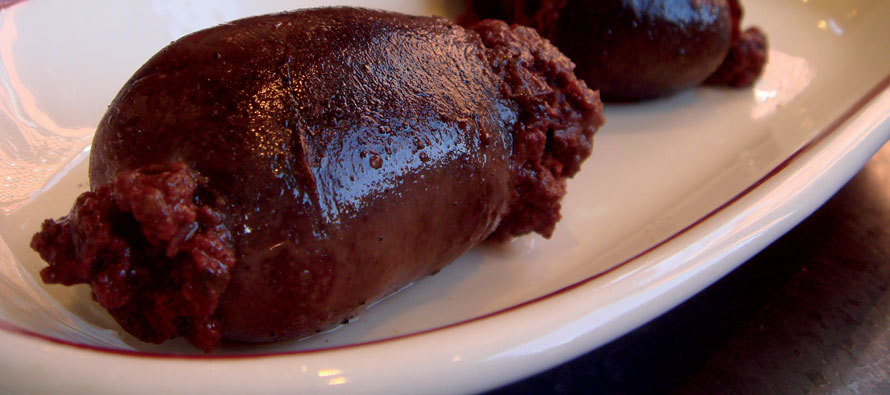Off the Eaten Path: Blood Sausage

Food is a divine pleasure in life, to be hedonistically consumed without regard to its previous state of existence, allowing one to fully enjoy the wide range of texture and flavor available.
To deny oneself the joys of eating something simply based on cultural ideas of normalcy is to deny oneself of the joys of life experience. If it is edible, it should be eaten, just as music should be heard or art should be seen. Every culture has its gastronomic norms, but these are simply binders in which they limit themselves from truly enjoying all that life can offer.
That’s where I come in.
There are a lot of things your average American won’t eat. There are even more things that your average Omahan won’t eat. Despite being nestled quietly in the hearth of beef and pork production country, your average person has only ever sampled a small portion of the animals slaughtered and processed by our many meat packing plants. As much as I’d like to see everyone heading to their nearest taqueria and ordering some tacos sesos, it’s not the most comfortable cuisine for the average palate. People need to be made comfortable with the food they’re eating, and in order to do that we have to take baby steps. Where do we start? Let’s see…
On a recent expedition in search of ‘snout to trout’ eating, or something similar, I stumbled across these dishes.
Tongue (El Rey Taco)
Beef tongue is one of the most common meats found at your average Mexican taco truck, the lengua having been slow cooked for extended amounts of time, leaving only an incredibly lean yet surprisingly juicy piece of meat that doesn’t overwhelm the palate with gaminess but still manages to separate itself from any other part of the cow. Pair with a little lime juice and some salsa verde and you’ve found yourself a delicacy sure to impress the taste buds of anyone willing to give it a shot. Eastern and Northern European cuisine is as well riddled with boiled tongue dishes, typically boiled and sliced thin after having removed the outer skin and veins, creating a perfect deli meat for those who enjoy a little more flavor than your average roast.
Cheeks (Le Voltaire)
The cheek of most animals, which is prized in most every country, is in American culture often the most overlooked cut. Often one of the most worked areas of an animals body, especially so with any animal that chews cud, it is one area that begins the toughest but becomes most tender while retaining all of the flavor imparted by its surrounding tissues. Veal and pork cheeks are especially held dear by most of the world, being the most tender and containing the highest fat content, giving them a stronger flavor once cooked. Braising is common in French cuisine, simply and slowly cooked in a sauce of red wine, tomatoes, and herbs. The result leaves a piece of meat that can be enjoyed by even the wariest of gastronomic adventuring, nearly not requiring even chewing to break down in your mouth, simply melting with the tongue’s press into savory bits of meat. Among connoisseurs of whole roast hogs, there is no greater honor than being allowed the cheek after having been slow cooked for hours and turned into a meat that sits somewhere between a filet and a jelly.
Blood Sausage (Le Voltaire)
The French call it boudin noir. The Germans call it Blutwurst. The English call it black pudding. The Spanish call it morcilla. Blood sausage is in most countries considered standard cuisine, as it has many centuries of being a food of necessity. It’s one of the first foods produced from the slaughter of a cow or pig, being made up of a combination of the meat, the blood, and a filler consisting of some combination of potatoes, bread, onions, or herbs, occurring before the freshly drained blood is given a chance to coagulate. It’s only after the sausage is made and there has been a proper mix created from these ingredients that the blood is allowed to coagulate, giving the sausage a very slightly spongy texture that complements well the ground meat and filler bits. The taste, if prepared properly, gives only hints of iron making way for a savory experience that even the Japanese term umami can’t describe. It’s incredibly palatable to anyone from any walk of life, and would certainly be a favorite given a simpler name much as the English have, such as black pudding or black sausage. It’s the very example of nose to tail eating, making full use of any animal killed for consumption, not letting any part go to waste.
This is just a beginning- exploring the world beyond the bounds of culinary norms takes many years and a lot of guts- literally- in order to remove the conception that any part of an animal is less fit for consumption than another. By beginning with the aforementioned dishes as well as other common yet “different” dishes, easing the way into experimenting with foods not generally considered common becomes much easier, and hopefully, much tastier.
No comments
Write a commentOnly registered users can comment.











